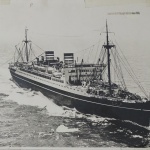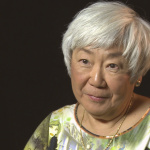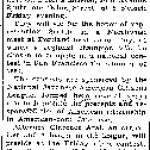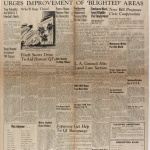Kotonk
A Japanese American from the continental United States vis-à-vis a Japanese American from Hawai'i. Originating from World War II era conflict between Hawai'i-born and U.S. mainland-born Japanese Americans in the 442nd Regimental Combat Team , the terms " Buddhahead " and "Kotonk" evolved to refer to the respective groups. Originating as a pejorative term, "Kotonk" is still used occasionally in Hawai'i today.
Origins
When Japanese American members of the 442nd Regimental Combat Team assembled for training at Camp Shelby in 1943, a divide between the Hawai'i-born and the mainland-born became immediately apparent. Some of this stemmed from the fact that prewar mainland draftees already in the army had been appointed to most of the noncommissioned officer positions before the Hawai'i recruits had arrived. But the conflict was mostly a result of miscommunication, stereotyping, and differences in the culture that had developed in the two places.
First there was the language. Japanese Americans raised in the multicultural stew of plantation -era Hawai'i spoke a variation of pidgin English (aka Hawaii Creole English), while the mainland Japanese Americans spoke in standard English. In Hawai'i, Japanese Americans who spoke standard English were viewed as being arrogant race traitors who thought they were too good to speak like everyone else; their attributes were immediately transferred to the standard English speaking mainland recruits. The Hawai'i group also regarded the mainland group as being only out for themselves and of being overly concerned with what other people thought. The mainland group saw the Hawai'i group as loud, uncouth, and bullying, the latter due to the frequent fights that saw large groups of Hawai'i men coming to the aid of any compatriot who got into a scrape. There was undoubtedly a grain of truth to these stereotypes due to the very different milieus that the two groups grew up in: being the largest ethnic group in a majority minority environment in Hawai'i versus being a small minority group who experienced severe discrimination—and whose families were mostly locked up in incarceration camps—on the mainland. [1]
The derogatory term "Kotonk" has several origin stories: "the sound of a mainland Nisei's head hitting the ground after a fight with a buddhahead," [2] "the hollow sound made when a coconut hits the head of a mainland Japanese American, indicating an empty head," [3] "the sound of a thump to a very hard or hollow head," [4] "the sound made by coal being shoveled into pot-bellied stoves by these Mainland Japanese-Americans when they were assigned to housekeeping detachments at Army Posts," "the sound produced by the heads of two Mainland Nisei being knocked together."' [5] The term undoubtedly also derives in part from the Japanese language sound effect "koton" for a thumping sound.
Virtually all accounts that point out the conflict between the Buddhaheads and the Kotonks ended with the two groups coming to understand and like each other over time. [6] Often cited is a trip some of the Hawai'i recruits took to the nearby incarceration centers at Jerome and Rohwer , Arkansas, that gave them some understanding of the world that the mainland recruits hailed from. According to Senator Daniel K. Inouye , "... Overnight the situation in Camp Shelby changed because the word went out like wildfire. The experiment worked. I went back and said, 'I got to tell you guys about these Mainlanders. You won't believe what I'm going to tell you.' And this must have gone on in every hut throughout camp. The next day, you thought you were visiting a new regiment. We were blood brothers. The regiment was not formed when we volunteered, nor when we arrived in Camp Shelby—it was formed after this visit. [7]
The comradeship that was formed in battle and the valor that was displayed by members of both groups under fire went a long way towards healing any rifts that developed between the two groups.
Contemporary Usage
The term is still used in Hawai'i today and still retains some of its pejorative roots. Many of the old stereotypes still exist. As Dennis Ogawa wrote in 1980, island Japanese Americans are said to be "open, happy-go-lucky, frank, friendly, and never try to get ahead at others' expense" while mainland Japanese Americans are "never open, confident, friendly but hesitant, taciturn, quick to complain, critical behind backs, very ambitious toward personal progress and promotion." In recent years, a new more positive attribute has been assigned to Kotonks—being more conscious of their ethnic identity and being more apt to fight for civil rights. [8]
For More Information
Adachi, Nobuhiro. Linguistic Americanization of Japanese-Americans in Hawaii .Revised edition. Osaka: Osaka Kyoiku Tosho Co., Ltd., 1998.
Duus, Masayo. Unlikely Liberators: The Men of the 100th and the 442nd . Honolulu: University of Hawaii Press, 1987. [History of the all-Nisei military units in World War II.]
Kotani, Roland. The Japanese in Hawaii: A Century of Struggle . Honolulu: Hochi, Ltd., 1985.
Matsuo, Dorothy. Boyhood to War: History and Anecdotes of the 442nd Regimental Combat Team . Honolulu: Mutual Pub., 1992.
Morimoto, Patricia Toshie, "The Hawaiian Dialect of English—An Aspect of Communications During the Second World War," M.A. Thesis, University of Hawaii, 1966.
Murphy, Thomas D. Ambassadors in Arms . Honolulu: Club 100, 1954. Reprinted in 1992.
Shibutani, Tamotsu. The Derelicts of Company K: A Sociological Study of Demoralization . Berkeley: University of California Press, 1978.
Footnotes
- ↑ See Masayo Duus, Unlikely Liberators: The Men of the 100th and the 442nd (Honolulu: University of Hawaii Press, 1987), 62–63; Roland Kotani, The Japanese in Hawaii: A Century of Struggle (Honolulu: Hochi, Ltd., 1985), 107–08; Dorothy Matsuo, Boyhood to War: History and Anecdotes of the 442nd Regimental Combat Team (Honolulu: Mutual Pub., 1992), 70–73; Thomas D. Murphy, Ambassadors in Arms . (Honolulu: Club 100, 1954. Reprinted in 1992), 114–16.
- ↑ Nobuhiro Adachi, Linguistic Americanization of Japanese-Americans in Hawaii rev. ed. (Osaka: Osaka Kyoiku Tosho Co., Ltd., 1998), 130, citing an article in the Honolulu Advertiser .
- ↑ Dennis M. Ogawa, "Sansei World: The Sansei and other Japanese," The Hawaii Herald 1.10 (Oct. 3, 1980), 12.
- ↑ Mary Wakayama and Arnold Hiura, "Two Camps with One Heart," The Hawaii Herald 4.23 (Dec. 2, 1983), 1.
- ↑ Kotani, The Japanese in Hawaii , 107.
- ↑ Tamotsu Shibutani 's account of The Derelicts of Company K is one exception.
- ↑ Quoted from Matsuo, From Boyhood to War , 73.
- ↑ Ogawa, "Sansei World," 12; see for instance Karleen Chinen, "Dialogue: JACL Observations," The Hawaii Herald 5.17 (Sept. 7, 1984), 2 and Mark Santoki, "Where Have All the Young JAs Gone?," The Hawaii Herald 17.21 (Nov. 1, 1996), A-3.
Last updated Oct. 16, 2020, 4:53 p.m..

 Media
Media








